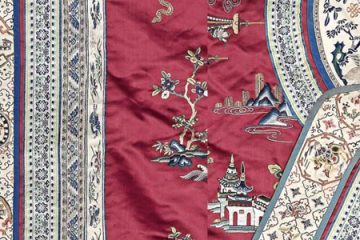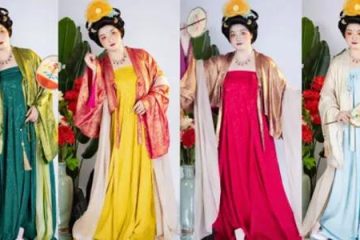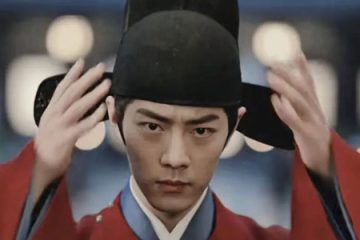Did Mulan Wear A Hanfu?

The live-action movie Mulan brings back so many memories for audiences worldwide—it even earned an Oscar nomination for Best Costume Design. Yet, when it first hit screens, Chinese viewers couldn’t stop discussing its Chinese outfit, makeup, and props. What might Mulan have actually worn back in her time? And what defined the movie’s take on her look?
Ⅰ. The Movie’s Version of Mulan
Remember Liu Yifei’s debut with that “goose-yellow makeup” and a lavish purple outfit?

Then there was Gong Li’s witch—a mythical character—dressed in dark, feather-covered garb.

Even the emperor’s costume didn’t escape online ridicule, with viewers joking: “Since when did the emperor’s hat look like that?” 🤔

In short, many viewers noted, “Even for Chinese audiences, the costumes and props feel pretty foreign.”
One of Mulan’s main outfits in the film featured a wrapped style of Chinese outfit known as the quju shenyi (曲裾深衣), which dates back to the Western Han Dynasty. In simple terms, it’s a long robe with overlapping front panels—the back panel extends into a long triangular flap that wraps from behind the wearer to the front and ties around the waist.

Mulan’s story is set during the Northern and Southern Dynasties, when ruqun was the trend, and the quju shenyi had largely fallen out of use. This is indeed historically inaccurate.
The film’s setting is the Northern and Southern Dynasties, yet much of the wardrobe resembles Chinese outfit styles more typical of the Tang Dynasty. For instance, in Mulan’s era, necklines were relatively modest—women often wore a white inner shirt with a curved collar as a base layer. Wide, low-cut collars didn’t become fashionable until the Tang period.

Sisters standing beside Mulan are dressed in Chinese outfits iconic of the Sui and Tang dynasties—combinations of short jackets, half-sleeves, and long skirts.

These costumes are historically off (not to mention women back then didn’t wear earrings). Though set in the Wei-Jin and Northern-Southern Dynasties, the film is filled with Tang dynasty clothing. The creative team, after poring over books and consulting experts, wanted to showcase diverse styles with era-specific traits. This design does add artistic flair, and Disney nailed the visually fantastical spectacle.
Ⅱ. A Stellar Example of Historical Accuracy: The Longest Day in Chang’an
Still, this has led to cultural misunderstandings, leaving many unfamiliar with Chinese outfits confused about its details. For a true look at “historically accurate restored Hanfu,” check out some Chinese period dramas. The Longest Day in Chang’an comes highly recommended—netizens praise its top-tier costumes, props, and makeup, with every detail faithfully recreated.

Take the character Xu Hezi (许鹤子), a singer in the show, for example—her look directly recreates the painted pottery figurine of a female dancer with double-loop “Wangxian Ji” (双环望仙髻) from the Tang Dynasty. No need for long explanations; just take a look for yourself: she wears a loose-sleeved jacket, overlaid with a collared, shoulder-flared half-sleeve, paired with a floor-length skirt—classic Tang Dynasty clothing for dancing.

Even the details like the neckline, cuffs, and the placement of the embroidered apron match perfectly. Anyone seeing it can’t help but say, “Impressive, really impressive!”
Other women are dressed in short blouses paired with high-waisted skirts—a style that flatters the figure, making it look graceful and tall. Also popular in the Tang Dynasty, this outfit is called a “qixiong ruqun”.

Comparing it to unearthed cultural relics in China, the costumes here are just as high-quality in their historical accuracy.

In any case, Chinese period dramas tend to be more historically accurate when it comes to costumes.
Ⅲ. What Mulan Might Actually Have Worn
Many short films or photo shoots about “Mulan” feature her with a sleek high ponytail. But real Northern Wei warriors didn’t dress that way. From Hollywood blockbusters to other depictions, there are some pretty obvious inaccuracies in these looks.
Let’s look at blogger “文翼是只老翼”’s recreation of the real Mulan.
First is her military attire: the armor, called “mingguang kai” (bright light armor), has mirror-like metal discs on the chest and back that glint in sunlight—true to its name. It offers full-body protection but is clunky to move in, weighing a whopping around 70 kg on its own.

The second set is a liang dang (禰裆) armor. A “liang dang” has one piece for the chest and one for the back, a style popular during the Northern and Southern Dynasties, often worn over clothing. Archaeological finds frequently show such armor paired with inner shirts. To keep the two-piece design snug around the waist, a belt is used, and loose trousers are tied with straps for easier movement.

When Mulan shed her male disguise and returned to her true self as a woman, her appearance underwent a striking change. Chinese outfit of this era largely carried on traditions from the Qin and Han dynasties, but was also influenced by northern nomadic cultures—resulting in looser styles like wide sleeves and flowing hems. Colors grew more vibrant, and patterns more elaborate.
Women’s fashion in the Wei-Jin period favored loose fits, typically featuring: mostly overlapping collars (with fewer cross-collared styles), a cinched waist, and broad sleeves. Cuffs, necklines, and hems were trimmed with contrasting colors. They wore striped, multicolored skirts, tied at the waist with a silk sash.
A wide-sleeved jacket with a layered skirt was common. Necklines, while open, weren’t low enough to expose the shoulders.
Northern dynasty women also painted pale yellow accents on their foreheads (not as bright as Liu Yifei’s look) and wore slightly exaggerated facial decals. The most iconic hairstyle of the time was the “crossed hairpin” style.



Summary
To wrap up, Disney’s style is inherently dreamy and fairy-tale-like. The live-action Mulan, adapted from Disney’s animated version, blends that fairy-tale vibe with Eastern elements—so it’s no surprise there are differences in how people perceive it. Still, kudos to Liu Yifei for her role in the award-winning film. 🤗
If anyone’s interested, I could do more blog posts to share facts about Mulan. Thanks for watching!



0 Comments